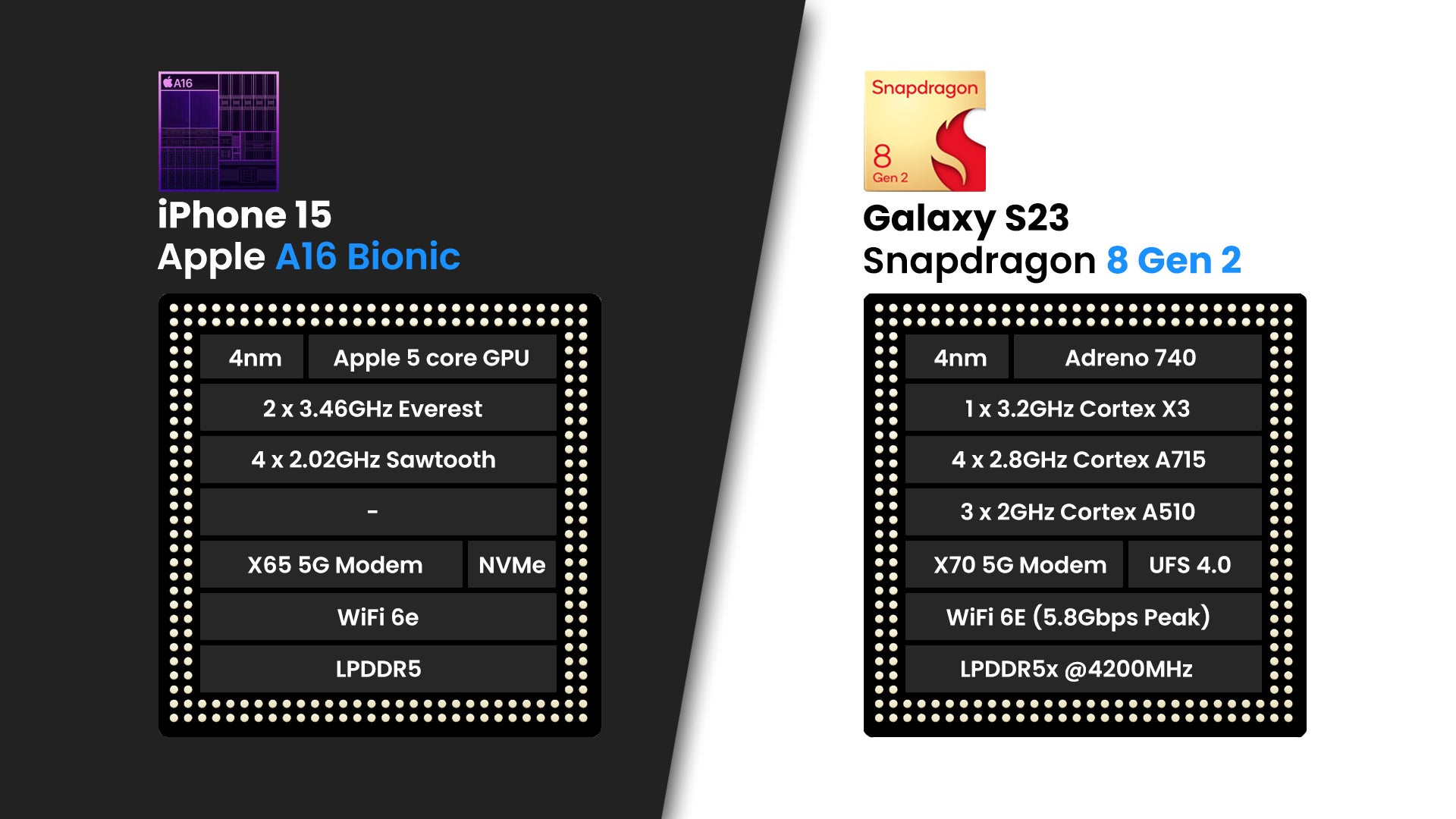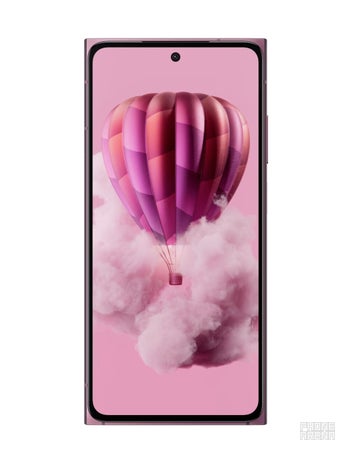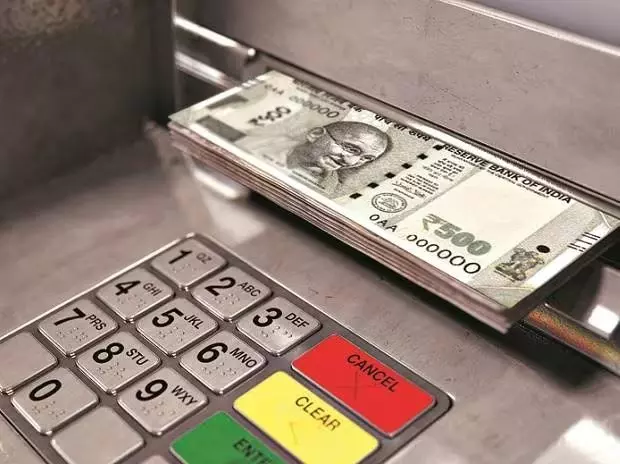Intro
- Same price
- A16 Bionic vs Snapdragon 8 Gen 2
- iPhone has 512GB storage option
- Galaxy S23 comes with a third camera (3X zoom telephoto)
- The S23 has double the display refresh rate of the iPhone
- Same battery life and charging speed
- iPhone’s display has higher peak brightness
Table of Contents:
Design and Size
The safe route
One major visual difference is the iPhone 15‘s adoption of the Dynamic Island, which comes with a variety of software functionality. The Galaxy S23however, boasts a less intrusive punch-hole cutout for the selfie camera.
Lastly, there is the USB-C port that finally replaced iPhone’s outdated Lightning alternative. Now, it is only the Pro models that get some actual benefits thanks to this transition (faster transfer speeds), but at least the new USB-C braided cables come with all iPhone 15 models.
Display Differences
It’s time to get with the times
Moving away from notches and islands, let’s talk about the more important aspects of a phone’s display. The Galaxy S23 comes with a 6.1-inch AMOLED screen that is capable of up to 120Hz screen refresh rate. Unfortunately, the iPhone 15 is still stuck only at a 60Hz refresh rate, the same as on all previous generations. The higher refresh rate remains exclusive for the Pro models.
Performance and Software
A16 Bionic vs Snapdragon 8 Gen 2

Given that we are talking about different types of operating systems, however, comparing the two chips is a complicated and arguably irrelevant matter. The two might show different results in benchmark tests, but what’s important is that both can handle real use-case scenarios in a similar manner.
The same can be said about the difference in RAM, which is 6GB on the iPhone and 8GB on the Galaxy. Both phones utilize RAM in their unique way, so the numbers here should not concern you too much. The good news is that the type of memory is the same fast LPDDR 5 memory.
The only difference between the two is the amount of maximum memory they come in, which is 256GB for the S23 and 512GB for the iPhone 15.
When it comes to software support, the iPhone takes the win with 5 years of major OS updates, while the Galaxy comes close with 4 years. One benefit of Android 13 and Samsung’s One UI 5.1, though, is that it is generally more customizable compared to iOS.
Camera
More is… more?
The most obvious difference between the iPhone 15‘s and Galaxy S23‘s camera systems would be the additional 10MP telephoto shooter featured on Samsung’s contender. Having that 3x optical zoom often comes in handy, and Apple has sorely been missing this hardware on its base iPhones so far.
Both phones come with 12MP ultra-wide and selfie cameras that support autofocus.
Audio Quality and Haptics
The Galaxy S23 came with noticeable improvements when it comes to its dual speakers and the audio quality they produce. Both phones should sound great when compared back to back, but we expect the iPhone 15 to be slightly better when we get to test it out, given what previous iPhone generations are capable of on this front. The same goes for the haptics.
Battery Life and Charging
Similar results
Battery life can vary depending on the scenario, but in general, we expect the iPhone 15‘s battery to last a bit more compared to the S23. That is mostly thanks to the power efficiency iPhones tend to come with thanks to their software optimization. There is also the A16 Bionic that is quite good at preserving energy.
As for juicing these babies up, the iPhone 15 comes with the same 20W maximum wired charging, despite its new USB-C port. The Galaxy S23 should be slightly faster in comparison, as it maxes out at 25W. Wireless charging speeds are the same for both, though, going up to 15W.
Specs Comparison
Here’s a summery of the specs for both the iPhone 15 and Galaxy S23:
| iPhone 15 | Galaxy S23 | |
|---|---|---|
| Size, weight | 5.81 x 2.82 x 0.31 inches, 6.03 oz (147.6 x 71.6 x 7.8 mm, 171.0 g) | 5.76 x 2.79 x 0.30 inches (146.3 x 70.9 x 7.6mm) 5.93 oz (168.0 g) |
| Screen | 6.1″ OLED, 60Hz, 2000 nits peak brightness, 1600 peak HDR brightness | 6.1″ AMOLED 120Hz |
| Processor | A16 Bionic 4nm |
Snapdragon 8 Gen 2 4nm |
| RAM, Storage | 6/128GB 6/256GB 6/512GB |
8/128GB 8/256GB – |
| Cameras | 48MP main 12MP ultra – 12MP front |
50MP main 12MP ultra 10MP telephoto 12MP front |
| Charging | USB-C 20W wired 15W MagSafe |
USB-C 25W wired 15W wireless |
Summary and Final Verdict
All of these perks that come with Samsung’s model, however, can easily go straight out of the window if you are a fan of iOS and Apple’s ecosystem of products and services. Also, we still don’t know which main camera will deliver better results when we pit the two against each other.
If you don’t care whether you are team Apple or team Samsung, though, the Galaxy S23 sounds like the better bang for your buck device for now, at least based purely on the spec sheets. That said, if you are still unsure which one you would like more, it might be best to wait for our full comparison after we’ve had time with the iPhone 15 and put it through its paces.







